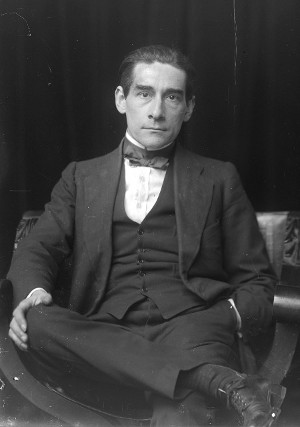 This dapper fellow is E.O. Hoppé, Great Britain’s German-born society-and-arts photographer (1878-1972) whose current show at London’s National Portrait Gallery has spawned very positive reviews. [Click on E.O.’s photo for better view]
This dapper fellow is E.O. Hoppé, Great Britain’s German-born society-and-arts photographer (1878-1972) whose current show at London’s National Portrait Gallery has spawned very positive reviews. [Click on E.O.’s photo for better view]
And it all has a Los Angeles connection.
arts·meme friend, Graham Howe, who divides his time between Sydney and Pasadena, is a distinguished photography scholar who happened upon, and acquired, a lost trove of Hoppé prints and negatives in London. He now manages the E.O. Hoppé Estate Collection as the CEO of museum services organization, Curatorial Assistance, in Pasadena.
Hoppé photographed many in the Ballets Russes contingent (famously, Tamara Karsavina) during the company’s London seasons, which ran from 1909 until 1921. He was keen on capturing Nijinsky, but pinning down the elusive Russian proved tough sledding. Hoppé tells the story, in his own words, of eventually photographing Nijinsky on an impromptu basis, backstage, after a performance of Spectre de la Rose.
You can read Hoppe’s memoir, and view the Nijinsky photos on The Huffington Post.
The photos give jarring insight into Nijinsky, the man. In them, Nijinsky looks dazed, out of it, certainly in a zone. These shots exist in stark contrast to his much more posed, polished, iconic images; however disturbing, they’re real. Also interesting is seeing Nijinsky’s sister, the choreographer Bronislava Nijinska, pose in “Spectre”‘s female role, a part highly identified with Karsavina.
Life is so funny. I’d read the words “Spectre de la Rose” so many times, but never expected to actually see the ballet. But the Boston Ballet, in its 2009 Ballets Russes centennial celebration, restaged it and there, I finally viewed Fokine’s amazing work. It was beyond my expectation, fantastic, melding thrillingly with the Von Weber music. And when the Spectre made his exit out an open window — Nijinsky’s gasp-inducing leap — I felt his spirit in the theater. Spooky, marvelous, shattering.
Hoppé Portraits: Society, Studio and Street | National Portrait Gallery, London| thru 30 May 2011
Interested in Nijinsky? Read more

The reasons for Nijinsky’s behavior towards Hoppé, his expressions when being photographed in the hallway outside his dressing room, and Bronislava Nijinska’s performance in “Spectre de la Rose” (rather than Karsavina) can be explained by the nightmarish circumstances of this performing season.
Nijinsky had been thrown out of Diaghilev’s Ballets Russes for marrying Romola de Pulszky in 1913 during the company’s South American tour. In 1914, he was trying to form his own company, with great help from his sister, (Bronslava) and her husband, and several English patrons. They were able to book the Palace Theater which was a very small theater, mostly used for “Variety” performances (Anna Pavlova and her small company performed there). Thus, he was performing in very “reduced” circumstances. (This can be seen in the set shown in the photo of him and his sister.)
In addition, because it was his own company, he had a great deal of administrative responsibility, for which he was totally unsuited. He had several temper tantrums during this period. By the second week of the season (which was not going well) Nijinsky began having flu symptoms, and cancelled several of his performances, and the management brought in Vaudeville acts to substitute. It was his last performance in London. It also ruined him financially. (Sources: Richard Buckle and Bronislava Nijinska)